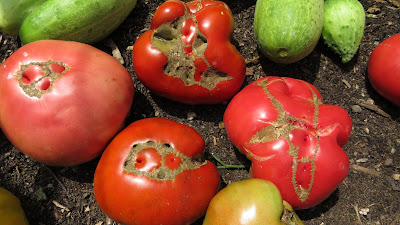The deformities most often occur on the bottom but can also show up on the sides and top of the tomatoes. Catfacing is most likely caused by environmental factors during fruit development. My belief is it is cause be temperature dips into the 40's in late spring and fall. You typically only see this occur on the first tomatoes of the season. However, there are other suggested reasons for it.
Cool Temperatures During Flowering:
Excessive Nitrogen Fertilization:
Chemical Exposure or Spray Drift: Some chemicals, particularly those that kill weeds and grass may disrupt fruit development and lead to catfacing. While this may be true, the entire tomato plant would be impacted and you would see distorted and twisted tomato leaves.
Catfacing will not affect the taste or usability of the tomatoes. You can still eat them and use them as you wish. They are perfect for making tomato sauce. You may see this type of deformity occurring early in the season and again in the fall. Very rarely, if at all, is it an ongoing problem.
Visit The Rusted Garden Seed and Garden Shop
for your Seeds, Starting Supplies, Fabric Pots, Neem Oil,
Peppermint and Other Oils, Calcium Nitrate and More.
The Rusted Garden Seed and Garden Shop
 |
| Tomato Catfacing or Bottom Deformaties |
Causes of Tomato Catfacing or Bottom Deformations
Cool Temperatures During Flowering:
Can disrupt the pollination process, leading to irregular fruit development and catfacing. This is what I have found to be most true over the years.
Treatment: Plant tomatoes well after the last frost date in your area to lower the risk to cold temperature dips during flowering. Temperatures falling in to the 40's Fahrenhiet or below 10 degrees Celsius are the typical temperatures of concern.
Extreme Temperature Fluctuations at Fruit Formation:
Extreme Temperature Fluctuations at Fruit Formation:
Rapid temperature fluctuations, especially from high heat days to cool nights may be the cause of catfacing. I have found higher temperature days leads to blossom drop or fruit drop but not tomato deformities.
Treatment: Maintaining consistent temperatures would be the only options and besides using shade cloth, there aren't many options to address temperatures.
 |
| At My Shop: Neem Oil and Peppermint Oil |
Excessive Nitrogen Fertilization:
High levels of nitrogen can lead to vigorous vegetative growth. Fast growth is suggested as a cause to catfacing but I have seen little evidence of this.
Treatment: Use a balanced fertilizer with a lower nitrogen content, or avoid excessive nitrogen use once plants are established.
Chemical Exposure or Spray Drift: Some chemicals, particularly those that kill weeds and grass may disrupt fruit development and lead to catfacing. While this may be true, the entire tomato plant would be impacted and you would see distorted and twisted tomato leaves.
Treatment: Use chemicals and weed killers wisely. Try and avoid use around edible plants.
Genetic Factors: Certain tomato varieties are more susceptible to catfacing due to their genetics. I have found the heirloom tomatoes that produce larger tomatoes are more prone to deformations. But, only for the first few tomatoes when the flowers are forming during periods of potential cold night temperatures. I have not seen catfacing occur regularly over an entire season on tomato plant.
Genetic Factors: Certain tomato varieties are more susceptible to catfacing due to their genetics. I have found the heirloom tomatoes that produce larger tomatoes are more prone to deformations. But, only for the first few tomatoes when the flowers are forming during periods of potential cold night temperatures. I have not seen catfacing occur regularly over an entire season on tomato plant.
Treatment: Choose tomato varieties known for less catfacing, if this is a recurring problem with certain varieties grown in your garden.
Catfacing will not affect the taste or usability of the tomatoes. You can still eat them and use them as you wish. They are perfect for making tomato sauce. You may see this type of deformity occurring early in the season and again in the fall. Very rarely, if at all, is it an ongoing problem.
"A Garden Wants to Grow"
Cheers!
Gary (The Rusted Garden)
 |
| Tomato Catfacing on Heirloom Tomatoes |
Subscribe to my
YouTube Channel The Rusted Garden Homestead
Over 650,000 Subscribers and Over 2000 Garden
Videos Designed to Quickly Present Information!
Visit The Rusted Garden Seed and Garden Shop
for your Seeds, Starting Supplies, Fabric Pots, Neem Oil,
Peppermint and Other Oils, Calcium Nitrate and More.
The Rusted Garden Seed and Garden Shop

No comments:
Post a Comment
Visit The Rusted Garden's YouTube Video Channel
Follow The Rusted Garden on Pinterest